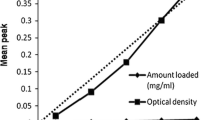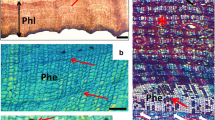Abstract
Reverse phase-high performance liquid chromatography was used to estimate the berberine content of Berberis jaeschkeana. The root and bark samples were harvested from different habitats (i.e., rocky and grassy), along an altitudinal gradient. The results revealed the presence of significantly (p < 0.05) higher berberine content in the samples of rocky habitats. However, the content varied significantly (p < 0.05) within habitats, seasons and among the habitats along an altitudinal gradient. Altitude has shown a strong negative correlation (p < 0.01) with berberine content. The overall results indicated the preeminence of root samples over stem bark samples, with regard to the berberine content. The findings of this study will help medicinal plant growers, pharmaceuticals to identify suitable habitats for the effective harnessing of alkaloids like berberine.


Similar content being viewed by others
References
Ahrendt LWA (1961) Berberis and Mahonia—a taxonomic revision. Bot J Linn Soc 57:296–359
Andola HC, Gaira KS, Rawal RS, Rawat MSM, Bhatt ID (2010) Habitat-dependent variations in berberine content of Berberis asiatica Roxb. ex. DC. in Kumaon, Western Himalaya. Chem Biodivers 7(2):415–420
Belwal T, Bisht A, Bhatt ID, Rawal RS (2015) Influence of seed priming and storage time on germination and enzymatic activity of selected Berberis species. Plant Growth Regul 77(2):189–199
Guo YP, Zin JH, Guang JW (2003) The anti-hyperglycaemic activity of berberine arises from a decrease of glucose adsorption. Planta Med 69:632–636
Kulkarni SK, Dhir A (2007) Possible involvement of l-argininenitric oxide (NO)-cyclic guanosine monophosphate (cGMP) signaling pathway in the antidepressant activity of berberine chloride. Eur J Pharmacol 569:77–83
Li Z, Geng YN, Jiang JD, Kong WJ (2014) Antioxidant and anti-inflammatory activities of berberine in the treatment of diabetes mellitus. Evid Based Complement Alternat Med. https://doi.org/10.1155/2014/289264
Kirtikar KR, Basu BD (1933) Indian medicinal plants I. Lalit Mohan Basu & Co., Allahabad, pp 100–108
Mikage M, Mouri C (1999) Pharmacoganostical Studied of Berberis Plants (Berberidaceae) from Nepal. Nat Med 53(5):249–254
Laitinen ML, Julkunen-Tiitto R, Rousi M (2000) Variation in phenolic compounds within a birch (Betula pendula) population. J Chem Ecol 26(7):1609–1622
Macel M, Vrieling K, Klinkhamer PG (2004) Variation in pyrrolizidine alkaloid patterns of Senecio jacobaea. Phytochemistry 65(7):865–873
Keurentjes JJB et al (2006) The genetics of plant metabolism. Nat Genet 38(7):842–849
Coleman JS, Jones CG (1991) A phytocentric perspective of phytochemical induction by herbivores. In: Tallamy DW, Raupp MJ (eds) Phytochemical induction by herbivores. Wiley, New York
Moore BD, Andrew RL, Külheim C, Foley WJ (2014) Explaining intraspecific diversity in plant secondary metabolites in an ecological context. New Phytol 201(3):733–750
Figueiredo AC, Barroso JG, Pedro LG, Scheffer JJ (2008) Factors affecting secondary metabolite production in plants: volatile components and essential oils. Flavour Fragr J 23(4):213–226
Murthy HN, Lee EJ, Paek KY (2014) Production of secondary metabolites from cell and organ cultures: strategies and approaches for biomass improvement and metabolite accumulation. Plant Cell Tiss Organ Cult 118(1):1–16
Collakova E, Della Penna D (2003) The role of homogentisate phytyltransferase and other tocopherol pathway enzymes in the regulation of tocopherol synthesis during abiotic stress. Plant Physiol 133(2):930–940
Ibrahim MH, Jaafar HZE (2011) Photosynthetic capacity, photochemical efficiency and chlorophyll content of three varieties of Labisia pumila benth: exposed to open field and greenhouse growing conditions. Acta Physiol Plant 33(6):2179–2185
Carey DB, Wink MJ (1994) Elevation variation of quinolizidine alkaloids content in a lupine (Lupines argenteus) of Rocky Mountain. J Chem Ecol 20(4):849–857
Mikage M, Mouri C (2000) Altitudinal variation of berberine content in the bark of Berberis plants from West Nepal. Newsl Himalayan Bot 26:16–19
Ranmer MF, Turner BL (1967) Systematic significance of lupine alkaloids with particular reference to Baptisia (Leguminosae). Evolution 21:508–517
Motomura H, Noshiro S, Mikage M (2007) Variable wood formation and adaptation to the alpine environment of Ephedra pachyclada (Gnetales: Ephedraceae) in the Mustang District, Western Nepal. Ann Bot 100(2):315–324
Greathouse GA, Watkins GM (1938) Berberine as a factor in the resistance of Mahonia trifoliolatam and M. swaseyi to phymatotrichum root rot. Am J Bot 25:743–748
Andola HC, Gaira KS, Rawal RS, Rawat MS, Bhatt ID (2011) Influence of environmental factors on production of berberine content in Berberis asiatica Roxb. Ex DC in Kumaun, West Himalaya, India. J Herbs Spices Med Plants 17(4):329–338
Korner C (1998) Alpine plants: stressed or adapted? Physiol Plant Ecol 39:297–311
Andola HC, Rawal RS, Rawat MSM, Bhatt ID, Purohit VK (2010) Analysis of berberine content using HPTLC fingerprinting of root and bark of three Himalayan Berberis species. Asian J Biotechnol 2:239–245
Singh R, Tiwari SS, Shrivastava S, Rawat AKS (2012) Botanical and phytochemical studies on roots of Berberis umbellata Wall. ex G. Don. Indian J Nat Prod Resour 3:55–60
Chander V, Aswal JS, Dobhal R, Uniyal DP (2017) A review on pharmacological potential of Berberine; an active component of Himalayan Berberis aristata. J Phytopharmacol 6(1):53–58
Elgorashi EE, Drewers SE, Staden JV (2002) Organ to organ and seasonal variation in alkaloids from Crinum macowanii. Fitoterapia 73:490–495
Bagchi GD, Dwivedi PD, Haider F, Singh S, Srivastava S, Chattopadhyay SK (2003) Seasonal variation in vasicine content in Adhatoda species grown under north Indian plain conditions. J Med Aromat Plant Sci 25:37–40
Brijwal L, Pandey A, Tamta S (2015) In vitro propagation of the endangered species Berberis aristata DC. via leaf-derived callus. In Vitro Cell Dev Biol Plant 51(6):637–647
Pandey A, Brijwal L, Tamta S (2013) In vitro propagation and phytochemical assessment of Berberis chitria: an important medicinal shrub of Kumaun Himalaya, India. J Med Plant Res 7(15):930–937
Acknowledgements
The authors thank former Directors Dr. P.P. Dhyani, Dr. Uppeandra Dhar and Dr L.M.S. Palni, G. B. Pant National Institute of Himalayan Environment & Sustainable Development, Kosi-Katarmal, Almora for providing necessary facilities and encouragement during the course of this study. Partial financial support from Directorate of Arecanut and Spices Development, Kerala is gratefully acknowledged. The authors also acknowledge colleagues of Biodiversity Conservation and Management Thematic group.
Author information
Authors and Affiliations
Corresponding author
Ethics declarations
Conflict of interest
The authors declare no conflict of interest in publishing this manuscript in PNASIB.
Additional information
Significance statement First time berberine content estimation of different plant parts of Berberis jaeschkeana is performed across different habitats, along an elevation gradient. Considering the high use-value of berberine and endemic status of target species, present study provides insights what are the possible habitats for the effective harnessing of berberine sustainably.
Rights and permissions
About this article
Cite this article
Andola, H.C., Gaira, K.S., Pandey, A. et al. Influence of Habitat Characteristics and Altitude on Berberine Content in Berberis jaeschkeana C.K. Schneid. Proc. Natl. Acad. Sci., India, Sect. B Biol. Sci. 89, 967–972 (2019). https://doi.org/10.1007/s40011-018-1014-9
Received:
Revised:
Accepted:
Published:
Issue Date:
DOI: https://doi.org/10.1007/s40011-018-1014-9




